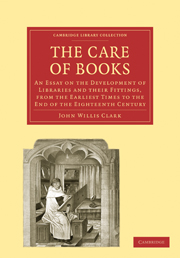 The Care of Books
The Care of Books Book contents
Summary
The evidence collected in the last chapter shews that what I have there called the Roman conception of a library was maintained, even by Christian ecclesiastics, during many centuries of our era. I have next to trace the beginning and the development of another class of libraries, directly connected with Christianity. We shall find that the books intended for the use of the new communities were stored in or near the places where they met for service, just as in the most ancient times the safe-keeping of similar treasures had been entrusted to temples.
It is easy to see how this came about. The necessary service-books would be placed in the hands of the ecclesiastic who had charge of the building in which the congregation assembled. To these volumes–which at first were doubtless regarded in the same light as vestments or sacred vessels–treatises intended for edification or instruction would be gradually added, and so the nucleus of a library would be formed.
The existence of such libraries does not rest on inference only. There are numerous allusions to them in the Fathers and other writers; S. Jerome, for instance, advises a correspondent to consult church-libraries, as though every church possessed one. As however the allusions to them are general, and say nothing about extent or arrangement, this part of my subject need not detain us long.
- Type
- Chapter
- Information
- The Care of BooksAn Essay on the Development of Libraries and their Fittings, from the Earliest Times to the End of the Eighteenth Century, pp. 51 - 94Publisher: Cambridge University PressPrint publication year: 2009First published in: 1902


